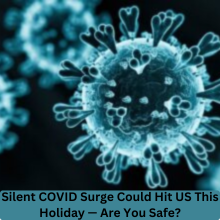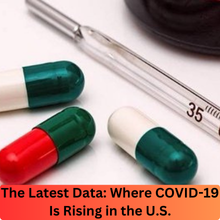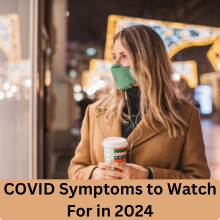Silent COVID Surge Could Hit US This Holiday
As the holiday season approaches, bringing with it an uptick in travel and social gatherings, a concerning trend is emerging across the U.S.: a “silent” surge in COVID-19 cases. After months of relatively low activity, experts are warning that a rise in transmission could catch many off guard. This surge is not as visible as previous waves, leading to what some have dubbed a “silent” outbreak. With people unaware of the increasing risk, COVID-19 could spread undetected, especially during the busy holiday season.
What Is a “Silent” COVID Surge?
A “silent” surge refers to a rise in COVID-19 infections that is not immediately noticeable because many of those infected exhibit only mild symptoms or none at all. Unlike past surges, where significant numbers of people experienced severe symptoms or were more likely to test for the virus, this wave is characterized by many individuals feeling only mild discomfort—if anything. Because of this, many might not even realize they are infected, making it easy for the virus to spread undetected.
Why It’s Called Silent
This surge is considered “silent” because it is happening quietly in the background. There has been no major public awareness, and people are not taking precautions because the virus isn’t showing up as aggressively as it has in the past. In many cases, the infected people might think they just have a mild cold or seasonal allergies, so they don’t bother testing or isolating.
Lack of Awareness and Undetected Spread
The main concern about this type of silent surge is that people don’t realize they are spreading the virus. When someone has mild or no symptoms, they are less likely to isolate or test for COVID-19, which contributes to further transmission, especially in crowded settings like family gatherings or holiday parties.
The Latest Data: Where COVID-19 Is Rising in the U.S.
Recent data from the U.S. Centers for Disease Control and Prevention (CDC) shows a notable rise in wastewater viral activity, a key indicator of the virus’s spread. According to the CDC, wastewater levels have sharply increased over the past two weeks in multiple states.
Wastewater Surveillance Data
Wastewater surveillance is a highly reliable method used to track the prevalence of COVID-19 in communities. This method can detect the presence of SARS-CoV-2 (the virus that causes COVID-19) in water systems, even before people start showing symptoms. As of mid-December, 21 states had reported “high” or “very high” levels of COVID-19 in wastewater.
The States with the Highest Viral Activity
Some of the states experiencing the highest levels of viral activity include Arizona, Arkansas, Illinois, Iowa, and Pennsylvania. While these areas are seeing the most significant uptick in COVID-19 cases, the virus is spreading across the country.
Why Wastewater Data Is Important
The reason wastewater data is so important is that it gives a clearer picture of community transmission than relying solely on reported case numbers. With fewer people testing and reporting their cases, especially those with mild symptoms, wastewater surveillance offers an early warning system.
Why This Year’s COVID Surge Is Different
The 2024 winter surge is arriving later than expected, and experts are unsure just how severe it will be. In previous years, COVID-19 cases would rise gradually in late October or November, but this year, the wave is starting later—right as the holiday season begins.
Late Onset of the Surge
Normally, the winter surge starts earlier, allowing people time to prepare and adjust their behavior. This year, however, COVID-19 levels remained unusually low throughout November and early December, giving people a false sense of security.
The Risk of Holiday Travel and Gatherings
Holiday travel and gatherings often create the perfect conditions for spreading infectious diseases. With people traveling across the country and congregating indoors, the virus has ample opportunity to spread undetected. Combined with the fact that many may not be aware of the rising risk, this creates a dangerous situation.
How the “Silent” Surge Spreads
Mild symptoms and a lack of testing are key factors contributing to the silent transmission of COVID-19 this winter. As people experience mild symptoms—such as a sore throat or slight congestion—they may not think to get tested or take precautions, unknowingly spreading the virus to others.
Mild Symptoms Leading to Underreporting
Many of the people infected with COVID-19 this winter will experience symptoms similar to a common cold. These might include a sore throat, runny nose, or mild cough—symptoms that are often overlooked or dismissed.
The Role of Highly Transmissible Variants
The virus currently circulating in the U.S. is highly transmissible, particularly the XEC and FLiRT variants. These variants are capable of spreading quickly, even among people with only mild or no symptoms.
Also read: Cold Christmas Morning in Central Florida: What’s Next?
Current COVID Variants in Circulation
The most common variants of COVID-19 right now are XEC and FLiRT. These subvariants are closely related to the original omicron strain but have evolved to be even more transmissible.
Why These Variants Are More Transmissible
The XEC and FLiRT variants have mutations that make them more capable of evading immunity from previous infections and vaccinations. This means that even people who have been vaccinated or previously infected might still be susceptible to these newer variants.
Symptoms Caused by These Variants
The symptoms caused by these variants are similar to those of previous omicron subvariants. They typically include mild respiratory symptoms, fatigue, and body aches. However, some people may experience more severe symptoms, especially if they are in higher-risk groups.
COVID Symptoms to Watch For in 2024
As the virus continues to circulate, it’s important to recognize the symptoms early to avoid spreading it to others.
Common Symptoms in the Current Wave
The most common symptoms include a sore throat, congestion, runny nose, and cough. Fatigue, headaches, and body aches are also prevalent. Some individuals may experience mild fever or chills.
How Symptoms Compare to Previous Variants
Compared to earlier variants of COVID-19, these newer strains tend to cause milder symptoms. However, that does not mean they are harmless. Even mild symptoms can lead to transmission, and those with underlying health conditions are still at risk of more severe disease.
Why COVID-19 Vaccination Is Critical Now
Vaccination continues to be one of the most effective ways to protect against severe illness, hospitalization, and death from COVID-19. The latest mRNA vaccine, updated for the 2024-2025 season, targets the currently circulating KP.2 “FLiRT” variant, offering robust protection against this strain.
The Effectiveness of the 2024–2025 Vaccine
The new booster vaccine is designed to offer protection against the latest variants. While no vaccine is perfect, staying up to date on vaccinations dramatically reduces the risk of severe outcomes.
Challenges in Vaccine Uptake
Unfortunately, vaccine uptake has been low, with only around 21% of U.S. adults having received the latest booster shot. This low vaccination rate puts the population at greater risk of catching and spreading the virus.
What Experts Are Saying About the Coming Weeks
Experts predict that COVID-19 cases will continue to rise in the coming weeks, especially with the influx of holiday travel and gatherings.
Concerns About Indoor Gatherings
Because people tend to gather indoors more during the winter months, experts are particularly concerned about the potential for super-spreader events. The close contact in indoor settings is an ideal environment for the virus to spread quickly.
What to Do If You Feel Sick During the Holidays
If you start to feel sick during the holidays, it’s crucial to take action right away to prevent spreading the virus to others.
Testing and Isolation Guidelines
If you suspect you may have COVID-19, take a test and isolate yourself until you receive results. Even if you have mild symptoms, avoid close contact with others to reduce the risk of transmission.
When to Seek Medical Attention
If you experience difficulty breathing, chest pain, or other severe symptoms, seek medical attention immediately. These could be signs of a more serious infection or complications.
The State of COVID Testing in the U.S.
Testing is still an important tool for tracking and controlling the spread of COVID-19, but it has declined significantly in recent months.
The Importance of At-Home Tests
At-home tests are a convenient option for many people. However, the accuracy of these tests can vary, and some may test too early to detect the virus. Despite this, using at-home tests can still help you make informed decisions.
How to Protect Yourself and Others This Holiday Season
Protecting yourself during the holidays involves taking some simple precautions.
Protective Measures to Consider
- Stay up to date on vaccinations
- Wear a mask in crowded places
- Maintain social distancing when possible
- Ensure good ventilation in indoor spaces
Also read: SpaceX’s Bandwagon-2 Launch: A Game-Changer for Space
Conclusion
As the holiday season continues, the risk of a silent COVID-19 surge is real. Experts warn that the combination of mild symptoms, low testing rates, and increased social gatherings could lead to an uptick in infections. Stay vigilant, protect yourself, and encourage others to take the necessary precautions to keep this holiday season safe.
FAQs
How can I tell if I have COVID-19 symptoms?
Look out for symptoms like sore throat, congestion, cough, fatigue, and mild fever. If you feel unwell, it’s always a good idea to test for COVID-19.
What’s the best way to stay safe at holiday gatherings?
Consider wearing masks in crowded indoor spaces, test before attending gatherings, and ensure proper ventilation in your meeting areas.
Are there specific precautions for traveling during the surge?
Wear a mask on planes, trains, and buses, wash your hands frequently, and avoid travel if you are feeling unwell.
Can I still catch COVID-19 after getting the vaccine?
Yes, it’s possible to contract COVID-19 after vaccination, but the vaccine significantly lowers the risk of severe illness.
What should I do if I feel sick during the holidays?
Test for COVID-19, stay home if you are sick, and follow local guidelines for isolation and treatment.


